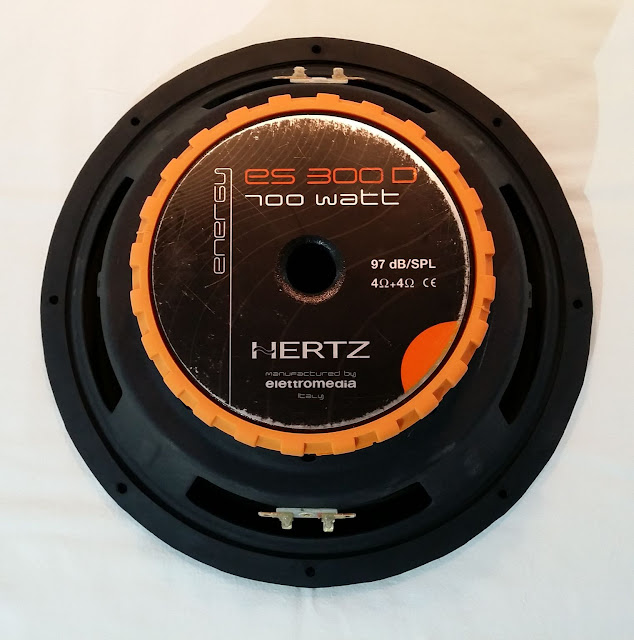 |
| image credit: Hertz |
For ES300D (as well as for "not D"), we recommend a ZYa with a volume of 20 - 30 liters and two versions of the FI.
Car Subwoofer Hertz ES300D
This sub looks indistinguishable from the one we tested a year ago, but this one has an 8-ohm two-piece coil (4 + 4). The basket is very thoroughly muffled. The cone material is traditional - cellulose with an outer synthetic coating. The center cap is provided with undershooting for rigidity, its diameter is 125 mm. The rubber boot covering the magnet is, by and large, non-removable, but the outer diameter of the ferrite, as usual, is indicated by the manufacturer - 141 mm. Coil ventilation, in addition to the axial hole (21 mm), is facilitated by six more holes in the washer along the periphery of the frame and a number of holes in the head body.
The suspension is made of polyurethane foam, its width is 2i mm. The outer perimeter of the body is closed with a C-shaped rubber rim. Together with plastic inserts, the design of the rim allows you to completely hide the fasteners (and not just their heads, as in the vast majority of "colleagues"). According to the unshakable tradition, the lead-in contacts are designed for “spatula” type terminals. When, as in this case, the contacts also need to be parallelized, the choice of such a design is no longer very practical.
 |
| image credit: Hertz |
For ES300D (as well as for "not D"), we recommend a ZYa with a volume of 20 - 30 liters and two versions of the FI. When simulating according to the measured parameters, the frequency response in the "factory" design will be somewhat different, the character will be the same, but everything will pass slightly below the design marks. We recommend the following: the minimum possible volume of the ZA is 22 liters, the phase inverter should be taken of a much larger volume, then both the frequency response form and the acoustic amplification will come into the desired harmony. Volume, however, is healthy, who is not satisfied - we roll back to the manufacturer's recommendations with volume correction upwards or even without it.
Calculations gave the mass of the mobile system 139 g (exactly the same, by the way, as in the ES300 test a year ago). The force factor, of course, is completely different here, 9.52 T m. If we translate this result into a "4-ohm equivalent" (by multiplying by the root of two), we get 13.5 T m, which is noticeably more than that of the 4- ohm variant. So the heads are really different. The reference sensitivity, according to our concepts, is average. Taking into account the solid amplification in the design with the FI, the real sensitivity is higher than 94.5 dB, and this is a decent indicator even for a "two". Harmonic distortion is low, and not only by our standards.
Pros
Low Harmonic Distortion. Decent sensitivity in FI
Hertz ES300D Specifications.
Frequency range: 25 - 250 Hz
Impedance: 4 Ohm
Housing: no
Recommended housing: closed box, vented
Cone material: cellulose
Magnet: ferriteMounting
depth: 141 mm
The installation hole: 276 mm
Type of winding: double









.jpg)


.jpg)



0 Comments